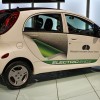The use of high-powered magnetic fields in the production of innovative vehicle maintenance has propelled more interest in this industry. The drive for reliable alternative fuel sources has necessitated the integration of new fuel-efficient technologies in the development of vehicles. With its energy capabilities and endless configurations, the magnet industry is an active component in the future of motor vehicles.
Charging cars with magnetic energy
According to Environment & Energy Publishing (E&E),
electric cars are being outfitted with strong magnets to enable wireless recharging capabilities. As more vehicles are integrating electronic supplies to power more than their inertia, such as loading trucks that use mechanical lifts, the importance of maintaining a charge is essential to their function. This is often a task that individuals forget to complete before engaging in other duties. The source reported that
HEVO Power is developing a wireless charging apparatus that will allow electric cars to charge wirelessly, away from home.
Rather than requiring a manual plug-in apparatus, owners can retrofit their vehicles with a responding sensor that activates the magnetic fields disguised as manhole covers. According to E&E, HEVO Power has selected New York City as the pilot location for this project. If it is successful, electric car owners could retroactively attach these devices to their vehicles at their leisure.
"The feedback has been very, very positive around the ease of use of the system ... as if people are becoming dependent or, I don't know, almost addicted to the technology," said Rebecca Hough, CEO and co-founder of wireless charging company Evatran, to the news provider.
Collecting power through magnetic coils
The technologies powering these wireless apparatuses mount receiving coils to the vehicles that transmit magnetic energy from corresponding transmitting coils located in the parking pads. This energy is then converted into an electrical current, which is collected into the core energy source of the battery.
The Engineer reported that
researchers at North Carolina State University have strengthened the power generated by segmented transmitter coils so that receiving wires are collecting more energy by up to 400 percent. The source noted that with more power, the possibility for magnetic leaks increases. This calls the long-term safety of these devices into question, as well as the efficiency of this system.
Before this solution can be launched in earnest, E&E noted that the health and safety of prolonged exposure to magnetic fields must be studied. Unlike exposure to high-powered magnets, such as
cube magnets or
sphere magnets, this technology will emit constant magnetic fields that produce yet undeterminable reactions in human beings. The cost of the charging apparatus could cost $3,000, which is more expensive than the standard plug-in method.
Making cars fly with magnetic power
According to the London Evening Standard,
magnetic fields might soon be utilized in the construction of hovering vehicles. Although the source expounded the possibility of a car that can fly through the air, the first step toward this feat of engineering is building a mode of transportation that can actually lift off the ground. By using an ionized gas and a powerful magnetic field, the news provider suggested, with approval from Futorologist Ian Pearson, that it would be possible for a vehicle to rise off the ground by at least 15-20cm.
It should be possible for manufacturers to create aircraft resembling the flying cars in "The Jetsons." According to the source, Paul Moller, a Canadian engineer who has spent millions of dollars on the technology, is hopeful.
"The basic physics is not that complicated. The problem is engines, engines, engines," Moller told the source.
Discover More With Apex Magnets
Want to stay up-to-date on the latest magnetic discoveries? Sign up for our newsletter to get these stories and more sent straight to your inbox each month. 
